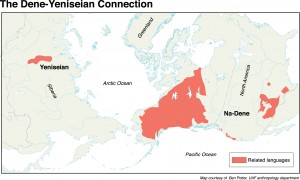New book chronicles Asia, North America language link
June 28, 2010

Marmian Grimes
907-474-7902
6/28/10
A team of researchers, including several at ąįė¹╔ń, have found what looks to be the first well-supported demonstration of an ancient language connection between people in remote Asia and North America.
Their work is chronicled in ŌĆ£The Dene-Yeniseian Connection,ŌĆØ a publication of the Anthropological Papers of the University of Alaska. In the book, lead author Edward Vajda of Western Washington University details his hypothesis that the Ket language of Central Siberia is related to the North American Na-Dene language family, which includes Tlingit, GwichŌĆÖin, DenaŌĆÖina, Koyukon, Navajo, Carrier, Hupa, Apache and about 45 other languages. Ket is the sole survivor of an earlier language family called ŌĆ£Yeniseian.ŌĆØ
The two language groups are separated by thousands of miles of land and an ocean, yet have similarities that indicate they came from the same roots. For scientists, these similarities are convincing evidence that these populations started out in the same area speaking the same language and then migrated via the Bering Sea land bridge.
VajdaŌĆÖs hypothesis is backed by an international group of scholars, including ąįė¹╔ń archaeologist Ben Potter and ąįė¹╔ń linguist James Kari, who both served as editors of the 369-page volume.
ŌĆ£What has taken place in the last three years with the publication of these articles is unprecedented as an initial academic presentation of a long-distant language relationship,ŌĆØ Kari said.
Vajda first announced his hypothesis at a ąįė¹╔ń symposium in 2008. Vajda has examined the similarities between the Ket language, currently spoken by a small, isolated group of people in central Siberia, and the North America Na-Dene languages.
Vajda found more than 100 shared cognates that are related by interconnected sound changes, as well as several verbal affixes that mark tense and aspect, and some shared pronouns. Cognates are words with a common etymological origin. For English speakers, it is similar to hearing the sameness of the English word ŌĆśfatherŌĆÖ and the Latin ŌĆśpaterŌĆÖ.
The results emphasize the importance of studying disappearing languages for what they can reveal about human prehistory, Vajda said. ŌĆ£The clearest lesson from comparing Yeniseian and Na-Dene is that effort spent documenting the worldŌĆÖs disappearing languages now can have vital impact on the future. Who would have imagined the ancient words Native American and Siberian boarding-school children were punished for speaking a few decades ago could wield a power vast enough to reunite entire continents?ŌĆØ
ŌĆ£The Dene-Yeniseian ConnectionŌĆØ is a joint publication of the ąįė¹╔ń anthropology department and the Alaska Native Language Center. With the publication of the 369-page book, linguistics specialists all over the world will have a chance to carefully examine the hypothesis and the supporting data.
ADDITIONAL CONTACTS: Jim Kari, professor emeritus of linguistics, at 907-479-8860 or via e-mail at james.kari@alaska.edu. Ben Potter, assistant professor of anthropology, at 907-474-7567 or via e-mail at bapotter@alaska.edu. Edward Vajda, professor of linguistics at Western Washington University, 360-650-4856 or via e-mail at edward.vajda@wwu.edu.
NOTE TO EDITORS: A PDF copy of an overview of the findings in the journal is available by contacting Grimes.
ON THE WEB: To order copies of ŌĆ£The Dene-Yeniseian ConnectionŌĆØ visit the ąįė¹╔ń anthropology department online at .
MG/6-28-10/259-10


